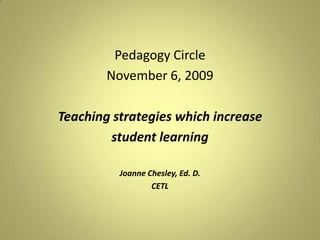
Teaching Strategies to Increase Student Learning
- 1. Pedagogy Circle November 6, 2009 Teaching strategies which increase student learning Joanne Chesley, Ed. D. CETL
- 2. What can teachers do to increase student learning ? 1 ) understand the brain and how it works utilize teaching strategies which reflect knowledge of brain cognition
- 3. Let’s look at the brain cognitions topic first!
- 4. The next time a student says, “I’m just not that bright!”, you tell him (her), that it is because he has not turned on all of the lights!
- 5. Our brains have the potential for 10 trillion connections among our neurons, but most of us only use 1% of our brainpower.
- 6. Each and every time we think, recall, observe, and learn, we are re-creating the brain—making new connections—turning on more lights (and getting BRIGHTER!!!!). These connections will become permanent if used regularly, making it easier to access that information next time.
- 7. Students learn by expanding their capacity to remember, and this amounts to: Opening the eyes and putting the brain on alert (Pay close attention). Converting the information to a form that can be stored (Visualization). Connect the experience to other information (Association). (Felberbaum, 2005)
- 8. Zones of Information People (recalling names and context) Spoken (remembering oral information) Numerical (recalling dates, formulas, money) Written (recalling what you read) (Felberbaum, 2005) Paying Attention, Visualization and Association (discussed earlier) help with the recall of these
- 9. Now let’s talk about teaching strategies which can increase learningby employing the tenets of brain-based learning.
- 10. Lecture combined with active learning can effectively lead to goal attainment. Case Method forces the learner to apply knowledge and to engage in discourse which increases perspective. Discussion, which is well planned, and appropriately structured, can enhance critical thinking, improve students’ appreciation and respect for others, increase confidence, and let the instructor determine students’ levels of understanding.
- 11. Under the Discussion umbrella we also have: debates, panel discussions, symposia, concentric circles, face-offs.
- 12. Active Learning Includes all forms of learning that allow students to talk, write, listen, reflect, practice, share, solve, and simulate. The approach is learner-centered, vs teacher-centered. The benefits include deeper understanding of the material, and more ability to apply, analyze, synthesize, as a result of connecting with the information in a more tangible way than as a listener only.
- 13. Cooperative Learning Small groups of learners work as a team, to share knowledge and tasks, and often earn the grade as a team. The work is internal. Collaborative Learning Varied groups (learners, teachers, departments, community, agencies) work as a team to share knowledge and tasks. The work involves external partners.
- 14. Integrated Technology Is not a strategy in and of itself …should be used in combination with any, or all of the above.
- 15. Questioning: Constructed Response Questions Your questions are carefully designed to ensure that students are able to answer. You ask them to increase knowledge using prior knowledge. For instance: “OK, on Monday, we learned that each neuron has axons and dendrites. How do you think connections happen between neurons? “ vs “Ok, Today we’re going to continue talking about neurons? Are there any questions about what we discussed on Monday?”
- 16. Questioning continued Reverse Thinking Instead of lecturing and then asking questions at the end to test students’ listening/retention , you would ask questions up front. This will allow them to think of the possibilities, the reasons, the causes, the effects, before you give it all away in your lecture. The brain grows when allowed to search for previously stored information, related information, visual images, memories associated with the topic. Taking the time to do this, to let the student ‘work the brain’ will go a longer way toward their ‘getting it’ than when you tell them everything and then simply ask them to spill it back to you. The latter does not effectively build as many new brain connections or strengthen old ones.
- 17. Visuals Illustrations on the board, done by students Illustrations on the board, done by teacher Concept maps Gallery walks You Tube, Teacher Tube Power Point Authentic artifacts
- 18. Role Playing Carefully planned, this strategy can make the point in short time, can evoke sensitivity by causing the learner to better feel the effects of decisions, words.